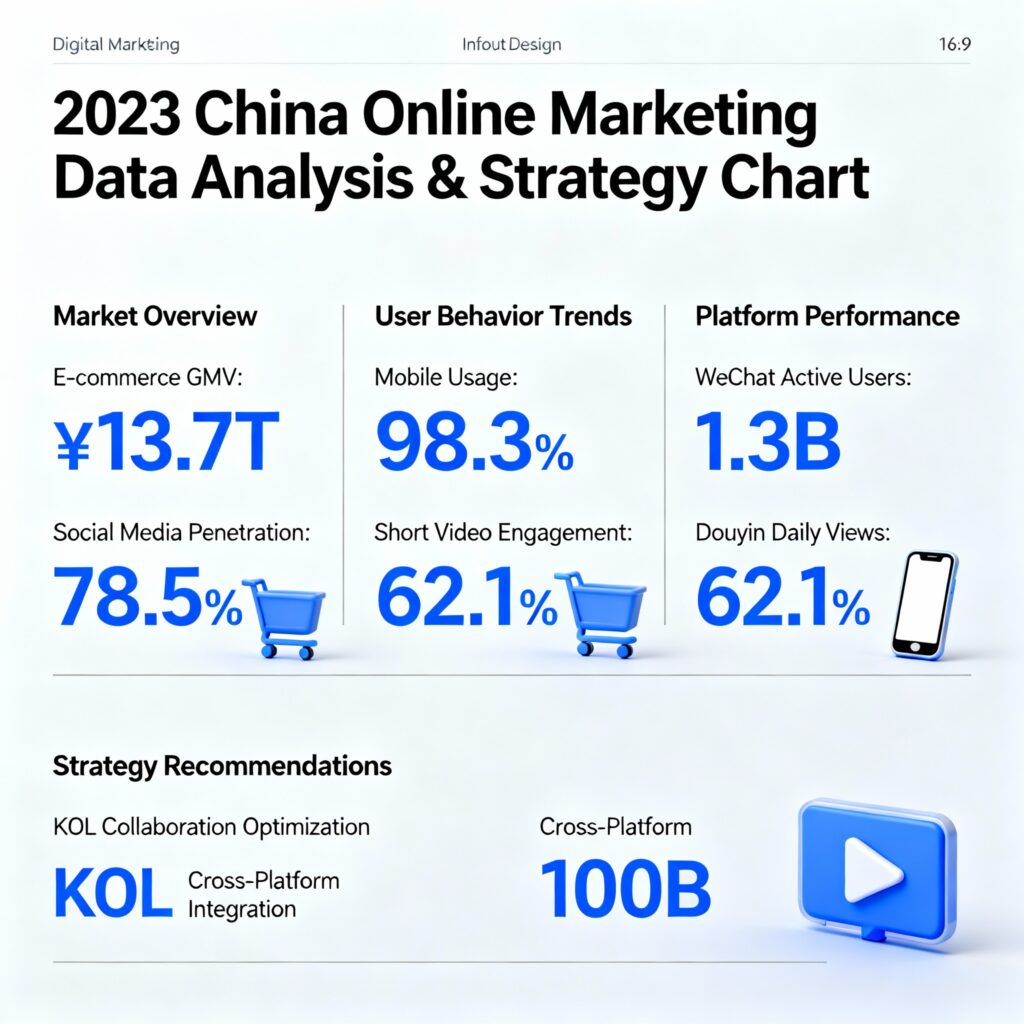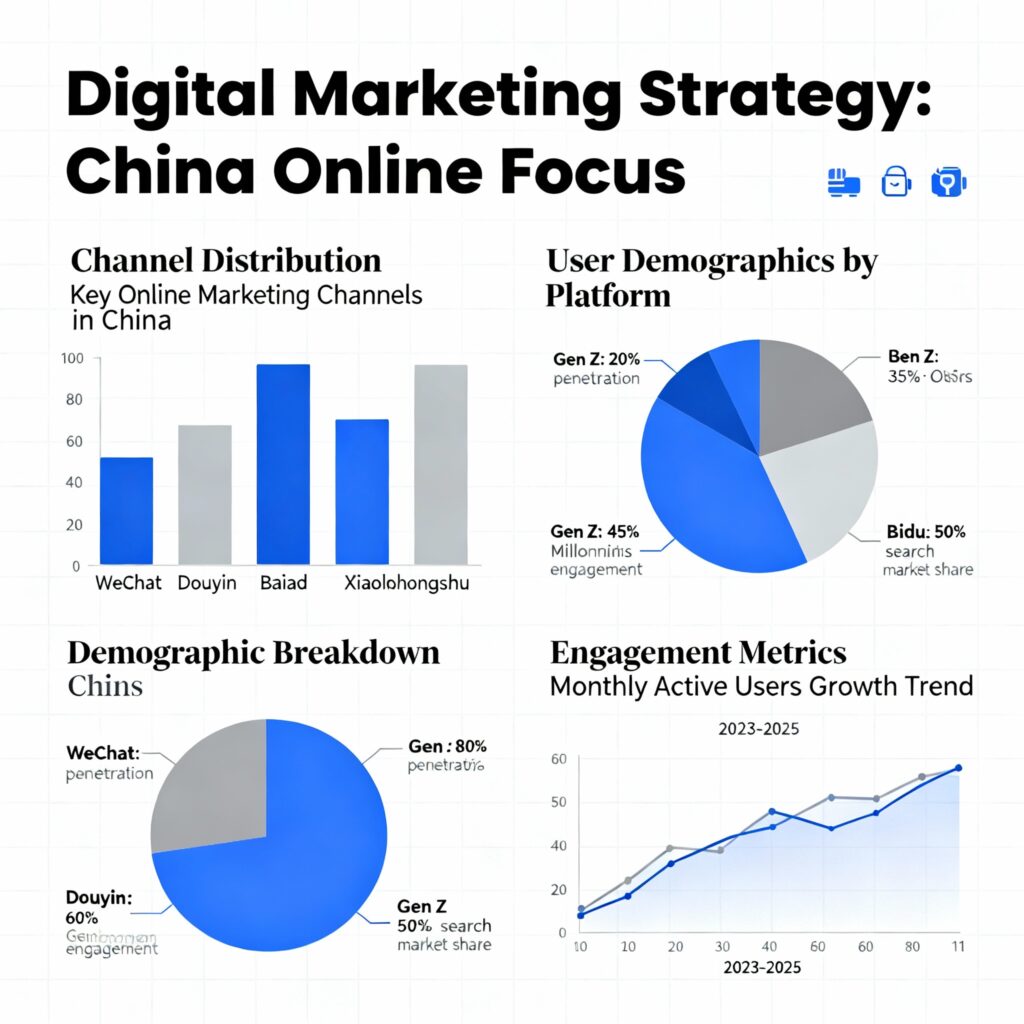
China represents the world’s most dynamic and lucrative digital marketing landscape, yet many international businesses struggle to navigate its unique ecosystem. With over 1.1 billion internet users and a staggering $200 billion in digital advertising spend, understanding online marketing in China has become essential for businesses seeking global expansion. This comprehensive guide explores proven strategies, platforms, and tactics that can help your business succeed in this complex but rewarding market.
Understanding the Online Marketing in China Landscape

The Chinese digital marketing ecosystem operates fundamentally differently from Western markets. While businesses in Europe or North America might rely on Google, Facebook, and Instagram, China’s digital landscape is dominated by entirely different platforms with unique characteristics and user behaviors.
As of July 2025, Baidu commands 56.23% of China’s overall search engine market share, with an even more dominant 71.91% on mobile devices. However, the landscape has become increasingly competitive, with Bing’s market share growing to 19.23% overall and an impressive 32.6% on desktop after integrating AI search capabilities. This shift underscores the rapidly evolving nature of online marketing in China, where platforms continuously innovate to capture user attention.
China Search Engine Market Share (July 2025)
| Search Engine | All Platforms (%) | Mobile (%) | Desktop (%) |
|---|---|---|---|
| Baidu | 56.23 | 71.91 | 32.81 |
| Bing | 19.23 | 10.1 | 32.6 |
| Haosou 360 | 16.12 | 7.68 | 28.97 |
| YANDEX | 4.78 | 6.61 | 2.28 |
| Others | 3.64 | 3.7 | 3.34 |
China’s advertising market reached 13 trillion RMB in 2023, marking a remarkable 12.4% year-over-year growth. This expansion is driven by economic recovery and the proliferation of AI-powered marketing tools that enable unprecedented precision targeting. For businesses looking to tap into this growth, understanding the key statistics and trends is crucial.
Key Online Marketing Statistics in China (2024-2025)
| Metric | Value/Statistic | Source Year |
|---|---|---|
| Internet Users | 1.1 billion | 2024 |
| Internet Penetration Rate | 78.6% | 2024 |
| Mobile Payment Users | 1.022 billion | 2025 |
| Digital Ad Spend | $200 billion (2024) | 2024 |
| Social Media Ad Spend | $84.7 billion (2024) | 2024 |
| E-commerce Market Value | $8.6 trillion (projected 2025) | 2025 |
| Influencer Marketing Market Value | $13.71 billion (2023) | 2023 |
| Online Advertising Market Growth Rate | 16.6% CAGR (2025-2030) | 2025-2030 |
The mobile-first nature of online marketing in China cannot be overstated. With 97% of internet users accessing the web via mobile phones, any successful digital marketing strategy must prioritize mobile optimization and mobile-native content formats.
Essential Platforms for Online Marketing in China
Success in online marketing in China requires mastering multiple platforms, each serving distinct purposes and audiences. Unlike Western markets where a single platform might suffice, Chinese consumers use different apps for different purposes throughout their customer journey.
WeChat: China’s Super App
WeChat dominates Chinese digital life with 1.4 billion monthly active users who spend an average of 90 minutes daily on the platform. This isn’t merely a messaging app—it’s a complete ecosystem encompassing social networking, e-commerce, payments, and customer service.
For businesses, WeChat offers multiple marketing tools. Official Accounts serve as brand hubs where companies publish content, engage customers, and drive sales. Mini-Programs—lightweight apps within WeChat—enable e-commerce transactions without users leaving the platform. Leading brands like Lancôme generate 30% of their China revenue through Mini-Programs.
WeChat Moments, similar to Facebook’s news feed, allows targeted advertising that seamlessly integrates into users’ social experiences. The platform’s integration with WeChat Pay and Alipay—which together account for over 90% of mobile payments in China—creates frictionless purchasing experiences.
Douyin: The Powerhouse of Short-Form Video
Douyin (China’s TikTok) has exploded to 835 million users by 2025, with 65% under 35 years old. The platform has revolutionized online marketing in China by blending entertainment with e-commerce, creating a shopping experience where purchases feel natural rather than forced.
The numbers speak volumes: Chinese consumers spend significantly more on Douyin than global users spend on other social media platforms, with a higher proportion spending over 5,000 RMB annually compared to approximately 2,000 RMB on Western platforms. This is driven by Douyin’s seamless e-commerce integration, influencer endorsements, and highly engaging short-form video content.
Live streaming commerce on Douyin has become a multi-billion dollar industry. As of June 2022, 44.6% of Chinese internet users have purchased products via live-streaming videos, with Douyin leading this trend through authentic, entertainment-driven product showcases.
Xiaohongshu (Little Red Book): The Trust Platform
Xiaohongshu has grown to over 200 million monthly active users, predominantly young urban women with considerable disposable income. Often described as a fusion of Instagram, Pinterest, and e-commerce, Xiaohongshu has become the go-to platform for product discovery and research.
What makes Xiaohongshu unique in online marketing in China is its emphasis on authentic user-generated content. 82% of Chinese consumers choose social media as their primary channel for gathering product information, and Xiaohongshu leads in trustworthiness. Users post detailed “notes” with photos, reviews, and tips, creating a community-driven shopping guide.
For brands, Xiaohongshu functions more as a marketing channel than a direct sales platform. Chinese luxury customers make exhaustive research before purchases, and Xiaohongshu will be one of their touchpoints. Even if consumers discover products on Xiaohongshu, they might purchase them hours or days later on Tmall or WeChat—making the platform invaluable for building brand awareness and trust.
Top Digital Marketing Platforms in China (2025)
| Platform | Monthly Active Users | Primary Use Case | Best For |
|---|---|---|---|
| 1.4 billion | Social media, messaging, payments, e-commerce | Customer engagement, brand loyalty | |
| Douyin (TikTok China) | 835 million | Short video, live streaming, e-commerce | Video marketing, influencer campaigns |
| Xiaohongshu (Little Red Book) | 200+ million | Content sharing, product reviews, e-commerce | Product discovery, user-generated content |
| 500+ million | Microblogging, news, social networking | Brand awareness, real-time engagement | |
| Baidu | N/A | Search engine, advertising | SEO, paid search advertising |
Baidu SEO: Mastering China’s Search Engine
While social platforms dominate attention, Baidu SEO remains foundational for online marketing in China, especially for businesses targeting users with high purchase intent. Baidu SEO differs significantly from Google SEO, requiring specific optimization strategies.
Language and Content Requirements
Over 83% of Baidu’s top-ranking pages are written in Simplified Chinese. This isn’t negotiable—content must be created in native Chinese by skilled writers who understand local nuances, idioms, and cultural context. Direct translations typically fail because they don’t capture how Chinese users search and read.
Keyword strategy on Baidu emphasizes exact keyword matches more than semantic context. Top-ranking pages average 1-2% keyword density, with target keywords placed early in title tags, headings, and body content. However, keyword stuffing is penalized, so natural, well-written copy that satisfies search intent is essential.
Technical Optimization
Baidu’s algorithm highly values the HTTPS protocol for security. Websites should obtain SSL certificates from within China and submit updated sitemaps to Baidu’s search console. Site speed is critical—Baidu prefers simpler, static pages over complex JavaScript frameworks. Using China-friendly CDNs and hosting improves crawling efficiency and user experience.
Link Building Strategy
Baidu values quality backlinks from authoritative Chinese websites. Links from official sources like newspapers or Chinese government websites carry significant weight. While quantity matters, authority and relevance of linking sites are more important. Building internal linking structures also helps Baidu’s spider crawl and index content effectively.
Domain-level trust plays a crucial role—once your site earns credibility, new content ranks faster and higher, creating a compounding effect. This makes consistent, quality content publication essential for long-term Baidu SEO success.
KOL and Influencer Marketing: The Power of Trust
Nearly half of young Chinese consumers trust product recommendations from influencers more than from brands themselves. This statistic underscores why KOL (Key Opinion Leader) marketing has become indispensable for online marketing in China.
The influencer marketing industry in China reached $13.71 billion in 2023 and is projected to grow to 3.9 trillion yuan by 2025. China is expected to hold over 65% of the global influencer market share by 2025, reflecting both market size and consumer trust in peer recommendations.
Types of Influencers
China’s influencer ecosystem includes several tiers. Top-tier KOLs like Li Jiaqi (Austin Li), known as the “lipstick king,” command over 100 million followers across platforms and can sell out product inventories in minutes. However, many brands find success with micro-influencers and nano-influencers who offer more targeted audiences and authentic engagement at lower costs.
Generation Z consumers—48% of the consumer population—particularly rely on KOLs for purchase decisions. This demographic’s trust in influencer recommendations drives the market’s explosive growth, with businesses allocating $150,000 to $420,000 for influencer collaborations.
Effective KOL Strategies
Successful online marketing in China through KOLs requires careful selection. Key factors include audience engagement (67%), brand affinity (78%), aesthetic alignment (53%), and cost (47%). Simply choosing influencers with high follower counts often backfires—approximately 45% of KOL followers across major Chinese social media platforms are detected as invalid, highlighting the importance of vetting partnerships carefully.
The most effective strategies include sponsored influencer activations (54%), product seeding/gifting (21%), and product giveaways (17%). Brands must also ensure proper disclosure—China’s advertising regulations require influencers to clearly mark paid promotional content.
E-commerce Integration: Where Marketing Meets Sales
Chinese online marketing in China is inseparable from e-commerce. The country’s e-commerce market is projected to reach $8.6 trillion in 2025 with 12% annual growth, and 946 million people purchased consumer goods online in 2024, spending $1.47 trillion.
Major E-commerce Platforms
Taobao and Tmall dominate with extensive mobile traffic and sophisticated recommendation algorithms. Taobao operates on a C2C model where individuals and small businesses sell directly, while Tmall focuses on B2C with established brands. JD.com differentiates itself through logistics excellence and authentic products, though its traffic has declined to 91.4 million monthly visitors.
Pinduoduo has disrupted the market through social commerce and group-buying models. Meanwhile, platforms like Douyin and Xiaohongshu blur the lines between content and commerce, allowing users to purchase products without leaving their social feeds.
Cross-Border E-Commerce Opportunities
For international brands without Chinese business entities, cross-border e-commerce (CBEC) offers a streamlined entry point. China’s CBEC market reached RMB 2.71 trillion in 2024, with 16.9% year-over-year growth in exports. The government supports CBEC through 178 pilot zones with simplified customs, reduced tariffs, and bonded warehouse systems.
Transactions below RMB 5,000 are exempt from import tariffs, and annual purchases under RMB 26,000 receive a 30% VAT reduction. Major CBEC platforms include Tmall Global, JD Worldwide, and Kaola, allowing brands to test the Chinese market with lower risk before committing to larger investments.
Mobile Payments: The Foundation of Digital Commerce
Mobile payments in China have reached unprecedented penetration, with 1.022 billion users as of June 2025. This represents a 38.3% penetration rate, the highest globally, and has fundamentally transformed how online marketing in China drives conversions.
Alipay dominates with 54% market share, while WeChat Pay holds 42%. Together, they account for over 90% of mobile transactions. The convenience of QR code payments—used in over 90% of mobile transactions—has made cashless transactions the norm in urban areas, with adoption rates exceeding 85%.
For businesses, integrating Alipay and WeChat Pay is non-negotiable. Over 95% of physical merchants accept both platforms, and mobile payments account for over 85% of in-store transactions in tier-1 cities. This infrastructure enables seamless shopping experiences where discovery on social platforms immediately converts to purchases.
Regulatory Compliance: Navigating China’s Digital Laws
Successful online marketing in China requires strict adherence to regulatory requirements. China’s Measures for the Administration of Internet Advertising, which took effect in May 2023, impose significant compliance obligations.
Advertising Regulations
All online advertising must be clearly identifiable as paid content, with the word “advertisement” displayed prominently. Paid search results must be distinguishable from organic results. Pop-up advertisements must include easily accessible one-click close buttons, and advertisers cannot deceive users into clicking through misleading methods.
Certain product categories—including medical treatments, drugs, medical devices, health food, and pesticides—require pre-approval from competent advertising censorship authorities. Content must strictly match approved materials without editing or modification.
ICP License Requirements
Websites hosted in China require an Internet Content Provider (ICP) license issued by the Ministry of Industry and Information Technology (MIIT). There are two types: ICP Filing for non-commercial websites and ICP Commercial License for websites conducting e-commerce or other commercial activities.
Obtaining an ICP license requires a legal entity in mainland China, making it challenging for foreign companies. However, websites hosted outside China (e.g., Hong Kong) do not require ICP licenses, though they experience slower loading speeds and restricted access within China, impacting user experience.
Emerging Trends in Online Marketing in China
The landscape continues evolving rapidly. AI-driven personalization has become dominant, with platforms like Taobao and JD.com using AI to customize product recommendations and marketing campaigns based on individual browsing behaviors and purchase history. AI-powered content, personalized shopping experiences, and automated customer service channels are key differentiators.
Private traffic management—building owned audiences through WeChat groups, loyalty mini-programs, and VIP communities—has gained priority as brands seek to reduce reliance on paid advertising. This shift toward owned channels provides more control over customer relationships and data.
Social commerce and gamification continue expanding. Platforms like Tmall integrate games during events like Singles’ Day, where users participate in “Store Partner” games to earn rewards, blending entertainment with shopping. This approach fosters community, competition, and sustained engagement while driving sales.
Consumer demand-driven marketing emphasizes timeliness, precision, and flexibility. Brands like Xiaomi and Huawei successfully leverage big data to anticipate consumer preferences, pushing tailored advertisements and product recommendations in real-time. Chinese consumers expect brands to respond quickly to evolving needs, whether through customized products, real-time promotions, or exceptional shopping experiences.
Q&A: Common Questions About Online Marketing in China
Q: Do I need a Chinese business entity to start online marketing in China?
Not necessarily. While having a local entity provides advantages for ICP licensing and platform access, cross-border e-commerce (CBEC) allows international brands to sell directly through platforms like Tmall Global without establishing a Chinese business entity. For marketing activities like social media presence and KOL collaborations, foreign companies can often partner with local agencies.
Q: How much should I budget for online marketing in China?
Budgets vary significantly based on objectives. For influencer marketing, businesses typically allocate $150,000 to $420,000. Baidu PPC advertising costs depend on keyword competitiveness and industry. Start with platform-specific pilots—WeChat official accounts, Baidu SEO campaigns, or KOL partnerships—before scaling successful channels.
Q: Which platform should I prioritize for online marketing in China?
This depends on your target audience and product category. B2C consumer goods benefit from Douyin and Xiaohongshu for discovery, WeChat for customer engagement, and Tmall/JD for transactions. B2B companies should focus on Baidu SEO, LinkedIn-equivalent platforms like Maimai, and WeChat for relationship building. Luxury brands find success on Xiaohongshu and WeChat, while mass-market products perform well on Douyin and Pinduoduo.
Q: How important is mobile optimization for online marketing in China?
Critical. With 97% of internet users accessing the web via mobile, mobile optimization isn’t optional—it’s foundational. All content, websites, and campaigns must be mobile-first. Fast loading times (under 1 second for Mini-Programs), mobile-friendly design, and seamless integration with mobile payment systems are essential.
Q: Can I use the same content strategy as my Western markets?
Rarely. Chinese consumers expect different content formats, tones, and platforms. Direct translation fails because it doesn’t capture cultural nuances, local idioms, or search behaviors. Successful online marketing in China requires localized content created by native Chinese speakers who understand regional preferences, trending topics, and cultural sensitivities.
Q: How do I measure ROI for online marketing in China?
Platforms provide robust analytics. WeChat Official Accounts offer readership data, engagement metrics, and conversion tracking. Douyin and Xiaohongshu provide insights on views, shares, comments, and click-through rates. Baidu Analytics tracks search traffic and user behavior. For e-commerce, platforms like Tmall and JD provide detailed sales data tied to marketing campaigns. Working with experienced agencies ensures proper tracking setup and interpretation.
Q: What are the biggest mistakes foreign brands make in online marketing in China?
Common mistakes include: treating China as a homogeneous market rather than recognizing regional differences; relying solely on translation rather than localization; underestimating the importance of KOL partnerships; neglecting mobile optimization; ignoring regulatory compliance; expecting immediate results without long-term commitment; and failing to integrate marketing with e-commerce for seamless customer journeys.
Partner with Dust Digital Marketing Ltd for Online Marketing in China Success

Navigating online marketing in China requires deep local expertise, platform-specific knowledge, and cultural understanding. Dust Digital Marketing Ltd., based in Hong Kong, specializes in connecting businesses with Chinese audiences through cutting-edge digital marketing solutions. Our team combines local market insights with international business acumen, enabling us to craft effective strategies that drive measurable results.
Whether you’re seeking Baidu SEO optimization, WeChat marketing campaigns, KOL partnerships, or comprehensive digital strategies, our experience across local and international markets positions us to help your business succeed in China’s dynamic digital landscape. We understand that online marketing in China isn’t just about translation—it’s about transformation, adapting your brand message to resonate with Chinese consumers while maintaining your core values.
The Chinese market offers unprecedented opportunities for businesses willing to invest in understanding its unique ecosystem. With the right partner, strategy, and commitment, your business can tap into the world’s largest digital economy and achieve sustainable growth. Contact Dust Digital Marketing Ltd today to begin your journey into online marketing in China.

